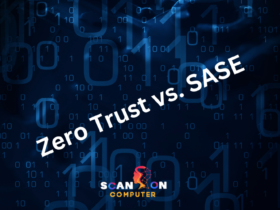Email spoofing poses a grave cybersecurity threat because it enables malicious actors to impersonate brands that users trust, using no advanced tools or technical know-how – bypassing spam filters and other common defense mechanisms in the process.
Be wary of emails asking for personal data or money transfers, and check the email header to see whether IP addresses and SPF validation match up. To avoid being scammed, be wary of requests for such personal details as well as money transfers. To protect yourself, always be suspicious of emails asking for such sensitive data or transfers. Additionally, double-check IP address matching with SPF validation for added peace of mind.
What is Email Spoofing?
Email Spoofing (aka sender spoofing) is an attack in which email senders forge the sender address of an email sent by them, often to impersonate someone with high profile like celebrities or business leaders. There are various techniques used for this practice with different degrees of complexity – one variation called Display Name Spoofing uses just that name (instead of forging all fields like an IP Address or sender address) in the From section to impersonate other names like celebrity figures or high profile business leaders.
Email spoofing is an increasingly prevalent tactic used in phishing attacks, spam emails, and other cyber-attacks. Attackers utilize these forged emails to trick victims into clicking harmful links or downloading malware attachments; or use it to damage a company’s reputation, commit identity theft or steal internal network access credentials.
Email spoofing is simple to accomplish because the Simple Mail Transfer Protocol (SMTP) lacks authentication mechanisms for email headers. Instead, these emails contain data describing when and where they were sent; hackers can alter this metadata to alter a sender’s address; often simply by altering their display name.
How is Email Spoofing Different from Phishing?
Email spoofing and phishing are both cyber threats that use deception to get someone to open an infected email or click a malicious link, with phishing often having malicious intentions while email spoofing often having more personal motives.
Spoofing allows bad actors to bypass email gateways by imitating trusted brands or individuals who the victim knows and relies on, bypassing spam filters and other common defenses against phishing attacks and redirecting victims to fake lookalike websites that ask for sensitive data such as passwords or credit card numbers.
Information gathered through spoofing can be used to steal an individual’s identity or gain financial gain, spread ransomware and take over their computer to encrypt files – all without them even realizing it! Most types of spoofing can be identified by checking an email header for SPF, DMARC and DKIM validations that appear. If these validations do not appear then the email was likely produced by third-parties who are infected with malware.
How Does Email Spoofing Work?
Email spoofing allows cybercriminals to trick recipients into believing they’re receiving an authentic email from someone they trust, which can then be used in various cyber attacks such as phishing and spreading malware such as ransomware.
Cybercriminals utilize fraudulent emails to gain access to confidential data by pretending to be friends or trustworthy businesses, requesting employees make wire transfers or provide other urgent requests – this form of attack is known as Business Email Compromise (BEC).
Email spoofing requires cybercriminals gaining access to a sender account and altering message header data – including fields such as TO, FROM, DATE and SUBJECT – before sending it out as spam to victim mailboxes with an aim of tricking them into providing sensitive information or clicking malicious links. All this is made possible due to an inadequate email system which does not implement protocols to verify sender addresses and authenticate sender identities.
How Can Email Spoofing Be Dangerous?
Email Spoofing is a dangerous cyber security attack as attackers use it to mislead recipients and gain unwarranted access to their computer, online accounts or private data. Cybercriminals may also use such emails to deliver malware that compromises both recipients’ personal and professional lives.
Receivers who open an erroneous email from someone they believe to be trustworthy may be more inclined to provide personal or sensitive data that could lead to financial fraud, identity theft or other grave consequences.
email users can help reduce the risks of email spoofing by exercising caution and adopting secure practices. In particular, recipients should be wary of emails that encourage immediate action or request sensitive data; similarly they should avoid clicking links or opening attachments that appear suspiciously quickly. They can also verify the authenticity of each message’s header by verifying whether its reply-to address matches what appears in its header – any inconsistencies or oddities would indicate possible fraudulence in its transmission.
Email Spoofing Protections
Email spoofing can be prevented through various protocols, email security tools and employee education measures. Sender Policy Framework, Domain Keys Identified Mail and Domain-based Message Authentication Reporting Conformance (DMARC) protocols can protect organizations from spoofing attacks by publicly listing company email servers’ information within domain name services (DNS), thus helping stop phishing attempts as well as spamming attacks.
As another way of combatting email spoofing, inspect email headers. Most email clients, such as Gmail, provide the option to view an email’s full header. This reveals important details about its source – for instance the original From field and Reply-to/Return Path fields may reveal evidence that the email has been falsified; while those that change or omit original From fields likely represent fraud.
Employees should remain vigilant against emails requesting personal or urgent action, such as money transfers or changes to login information for online accounts. When these types of requests arrive in their inboxes, recipients should double-check with another channel such as phone call or secure chat to reduce successful phishing attacks and mitigate business email compromise (BEC), which cost businesses an average loss of $5.96 Million between 2016-2021.
How to Identify Spoofing Email?
Email spoofing is often employed in phishing attacks and can be extremely harmful to recipients. An attack could take control of online accounts, spread malware or steal sensitive information; so individuals and organizations alike should practice not giving out personal details via email.
To determine whether an email is fraudulent, it is crucial to examine its header. Email headers contain important tracking data which reveals whether an email has been falsified or comes from a legitimate source.
Before clicking any links or attachments in an email message, it is crucial to confirm its authenticity. Spoof emails often solicit passwords or personal data in an effort to convince their recipients into divulging their credentials voluntarily. Those wishing to protect themselves against spoofed emails should verify both the email address and name, as well as consider its content – should it seem too good to be true, for example?
Email Spoofing Statistics
Email spoofing is often utilized in phishing attacks to deceive recipients into divulging personal data, clicking dangerous links, and taking other dangerous actions. Attackers use various tactics to conceal malicious attachments and links as legitimate ones – from disguising them as office printer-scanned documents, delivery failure messages, order and payment confirmations and highly specific flight confirmations all the way up to using different formats, logos, color schemes and signatures in emails that contain inconsistencies to detect faked emails. To identify faked emails quickly examine message formats, logos, color schemes, language signatures for telltale signs.
Attackers use both email spoofing and caller ID spoofing to pose as someone the recipient knows, frequently in Business Email Compromise (BEC) attacks where attackers pose as executive executives to coerce employees into wire transfers or divulging sensitive data. Spoofed email attacks pose a significant threat to businesses but are hard to detect without the proper tools in place; there are ways of protecting against email spoofing such as spam filters and security measures such as DMARC; however more advanced techniques or targeted varieties may remain hard to detect.
How to Protect Against Email Spoofing?
Email Spoofing can be a dangerous form of cybercrime because cybercriminals can create messages that appear legitimate to recipients, encouraging them to click links or download attachments and engage with it, potentially disclosing sensitive data or inviting malware onto their systems.
One way to defend against email spoofing is ensuring employees understand its risks and are equipped to recognize suspicious emails, which may require educational programs on how best to protect against it.
Another way to protect against email spoofing is through setting your email client with DMARC or SPF, which helps stop attacks by rejecting any email that doesn’t pass authentication. By doing this, attackers will find it more difficult convincing people and organizations to engage with their content. Furthermore, it is essential to remember that email spoofing tactics evolve constantly; even after employees have been trained on spotting potential phishing attempts it is vitally important that they keep training themselves on new tactics as phishing attempts may still attempts may come up – regardless if their employee have received training on detecting potential attempts they need ongoing updates so as not to become complacent!










Leave a Reply
View Comments